Mingora
Mingora (Pashto: مینګورہ, Mingawara; Urdu: مینگورہ) is a city in the Swat District of Khyber Pakhtunkhwa province, Pakistan. It is the 3rd largest city in Khyber Pakhtunkhwa and 26th largest in Pakistan. Mingora is the largest city and the epicenter of social, cultural, and economic activities in Malakand Division, and also the largest in the northern part of Khyber Pakhtunkhwa.[2]
Mingora مینگورہ | |
|---|---|
 View of Mingora | |
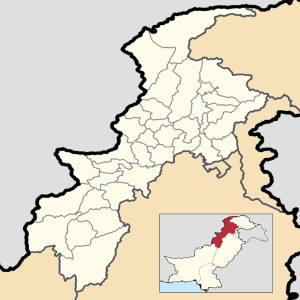 Mingora 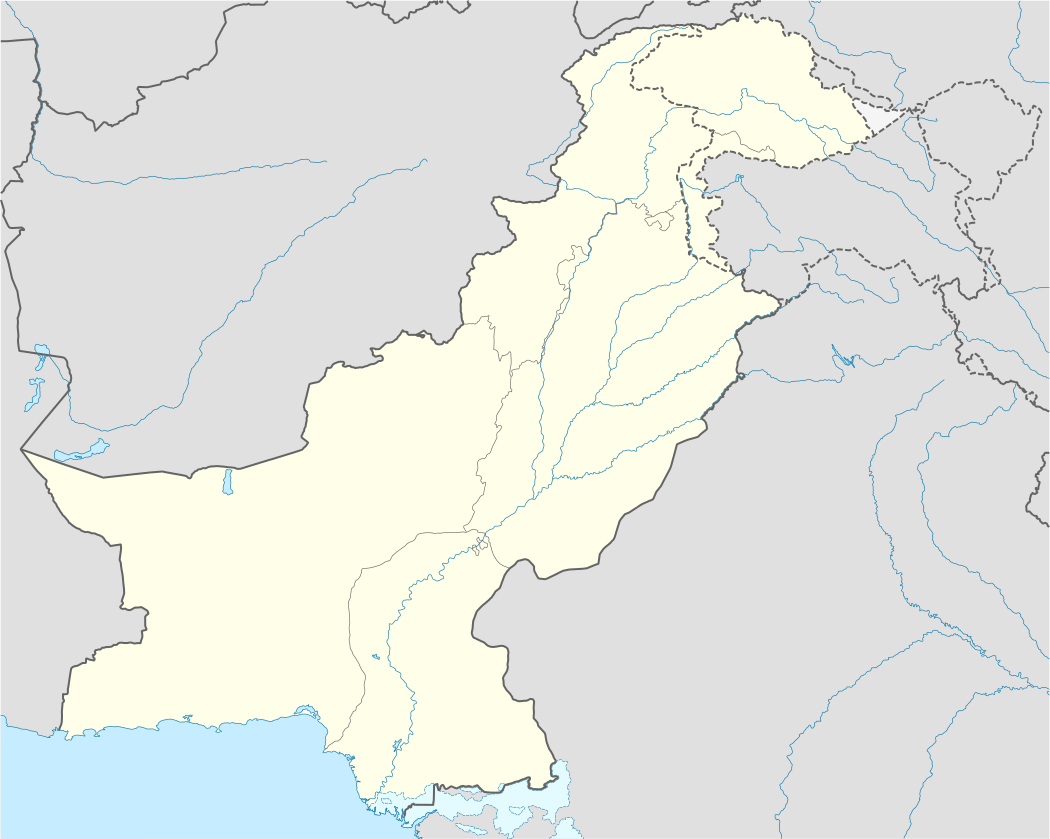 Mingora 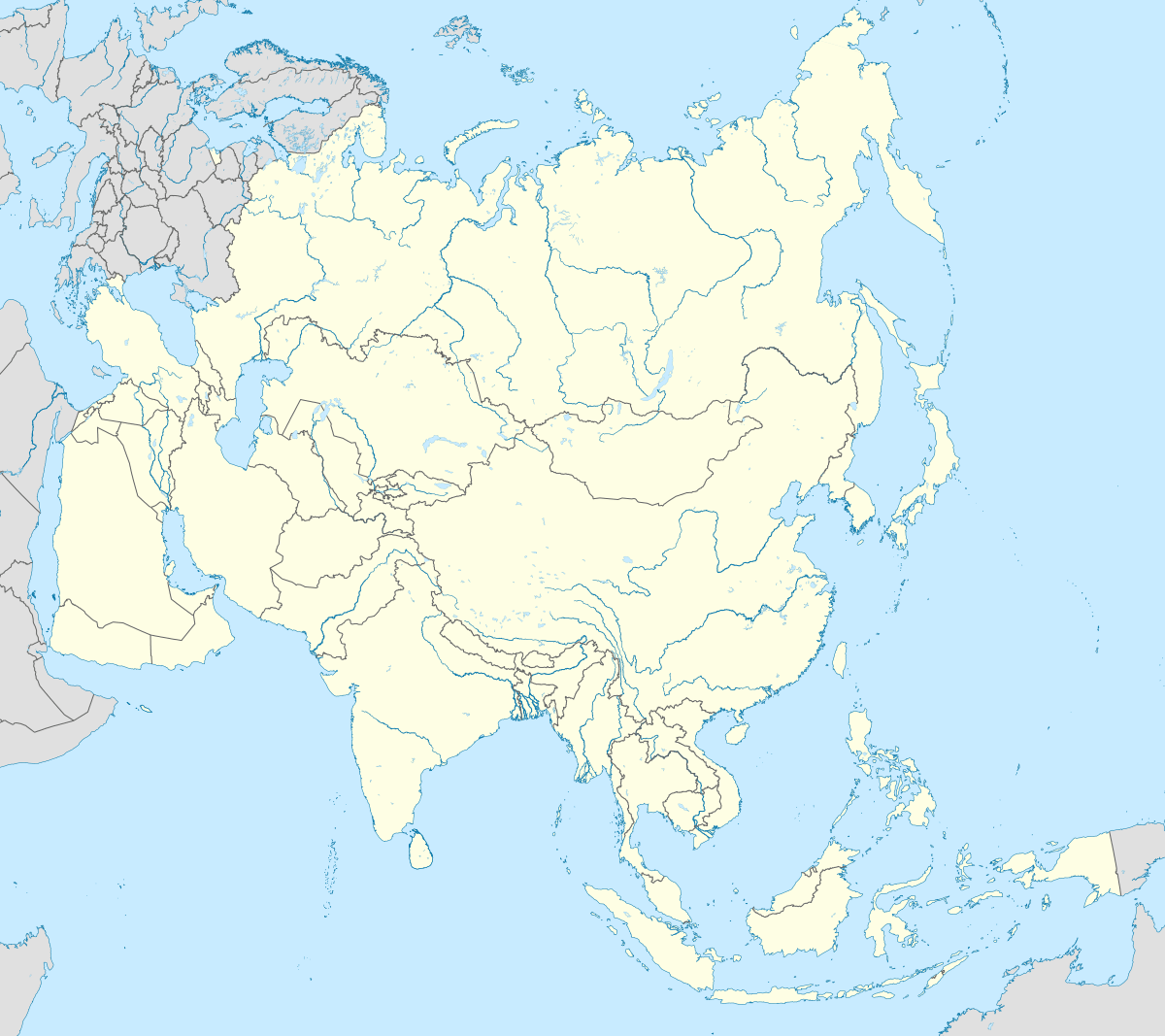 Mingora .svg.png) Mingora | |
| Coordinates: 34°46′18″N 72°21′36″E | |
| Country | |
| Province | |
| Division | Malakand |
| District | Swat |
| Tehsil | Babuzai |
| Elevation | 984 m (3,228 ft) |
| Population | |
| • City | 331,091 |
| • Rank | 26th, Pakistan; 3rd, Khyber Pakhtunkhwa |
| Time zone | UTC+5 (PST) |
| Calling code | (0946) |
| Website | Mingora |
History
Mingora's long history dates back to the remains of Indus Valley Civilisation.[3] At Loe Banr, Butkara II and Matalai, Italian archaeologists unearthed 475 Indo-Aryan graves dated between 1520 and 170 BC and two horse skeletons.[4] On the opposite side of the River Swat at Aligrama, near the Saidu Sharif airport, a site of Gandhara grave culture was discovered by Italian archaeologists and dated to 1000 BC.
Later the region came under the influence of Hinduism and Buddhism.[5] Hinduism took root in the region with the rise of Mahajanapadas of ancient India, the most famous being Gandhara. However, Buddhism began to arise in the region with the arrival of Buddhist monks from the Gangatic plains, but it became a political force in the region with the arrival of the Mauryan Empire. Under Emperor Ashoka, Buddhism became firmly established in the region. With the region being a launching ground for Ashoka's expansion of Buddhist missionaries to the western regions from the Mediterranean and West Asia. Many Buddhist remains and carvings[6] have been discovered near Mingora in the Jambil River Valley. At Panr, a stupa and monastery dated to the 1st century CE has been excavated. Vajrayana and Tantric Buddhism was the majority religion, with Hinduism being practiced by large number of local population of the area. During much of the late 300 BCE to up until the consolidation of Islam in the 10th century BCE Buddhism was firmly established in the area. In Mingora, Faxian claimed to have saw the biggest Buddist monastery, and large carving of the foot-prints of Buddha carved on the sides of the ridges at Teerat.[7] Excavations at Butkara, near Mingora, revealed a large and imposing central stupa surrounded by more than 200 votive stupas which was discovered by Pakistani archeologist in the 20th century.[8] Before, under the Archaeological Survey of India under the British Indian Empire, the tomb of Akand of Swat, a local Buddhist ruler, and the archaeological remains of the Butkara Buddhist stupa were discovered.[9] Politically, the region was dominated by various Hindu and Buddhist kings, with influence stretching from the Kushan Empire to the Pala Empire. The most significant dynasty having direct control of the area being the Hindu Shahis. Their rule marked the assent of Hinduism and Hindu polity in the region once again, after centuries of Buddhist rule and domination of the area.[10] Under the Hindu Shahis, the area saw the rise in Hindu culture and art. This can be noticed in the findings of ruins from the Hindu Shahi period in the area, most notable being forts and Hindu temples.[11] However, their rule came to an end with the rise of Islamic empire of Mahmud Ghazni. Mingora has been an important trading centre for the last two thousand years.[12]
In 2007 during the rise of the Taliban insurgency, Mingora was invaded by the Taliban, largely impacting traditional culture in Mingora. A year later, the militant leader Fazlullah, then leader of Tehreek-e-Nafaz-e-Shariat-e-Mohammadi, established a pirated FM channel in the nearby Mamdheri village, approximately five kilometers away from Mingora.[2] Fazlullah subsequently became leader of Tehrik-i-Taliban Pakistan in Swat Valley, encompassing the entirety of Mingora.[13][14] The oppresion of girls' education, Polio treatments, and freedom of expresion became imminent throughout Mingora as a result, causing challenges for residents and Mingora's Green Square, once the hub of Mingora's social and cultural functions, became the execution grounds of Taliban opponents and dissidents, government officials, and civil workers, with corpses being hung from electricity poles.[2] Shabana, a local singer and dancer, was brutally shot and killed by the Taliban with her body being dumped in Mingora's main roundabout.[15]
The Operation Rah-e-Raast in 2009 placed Mingora back into Pakistani control.[16]
Climate
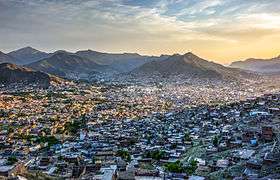
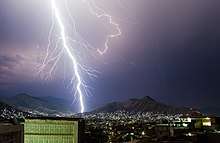
With a mild and generally warm and temperate climate, Mingora features a humid subtropical climate (Cfa) under the Köppen climate classification. The average annual temperature in Mingora is 19.3 °C, while the annual precipitation averages 897 mm. Even in the driest months, there is a lot of precipitation. November is the driest month with 22 mm of precipitation, while August, the wettest month, has an average precipitation of 134 mm.
June is the hottest month of the year with an average temperature of 29.2 °C. The coldest month January has an average temperature of 7.6 °C.
| Climate data for Mingora | |||||||||||||
|---|---|---|---|---|---|---|---|---|---|---|---|---|---|
| Month | Jan | Feb | Mar | Apr | May | Jun | Jul | Aug | Sep | Oct | Nov | Dec | Year |
| Average high °C (°F) | 13.0 (55.4) |
15.8 (60.4) |
20.2 (68.4) |
25.6 (78.1) |
31.7 (89.1) |
36.8 (98.2) |
35.4 (95.7) |
33.7 (92.7) |
32.3 (90.1) |
28.0 (82.4) |
21.8 (71.2) |
15.3 (59.5) |
25.8 (78.4) |
| Daily mean °C (°F) | 7.6 (45.7) |
10.3 (50.5) |
14.2 (57.6) |
19.2 (66.6) |
24.5 (76.1) |
29.2 (84.6) |
29.0 (84.2) |
27.8 (82.0) |
25.6 (78.1) |
20.5 (68.9) |
14.6 (58.3) |
9.4 (48.9) |
19.3 (66.8) |
| Average low °C (°F) | 2.1 (35.8) |
4.8 (40.6) |
8.2 (46.8) |
12.7 (54.9) |
17.3 (63.1) |
21.6 (70.9) |
22.6 (72.7) |
21.9 (71.4) |
18.9 (66.0) |
12.9 (55.2) |
7.4 (45.3) |
3.5 (38.3) |
12.8 (55.1) |
| Average rainfall mm (inches) | 81 (3.2) |
98 (3.9) |
125 (4.9) |
90 (3.5) |
46 (1.8) |
31 (1.2) |
130 (5.1) |
134 (5.3) |
64 (2.5) |
28 (1.1) |
22 (0.9) |
48 (1.9) |
897 (35.3) |
| Source: Climate-Data.org[17] | |||||||||||||
Notable people from Mingora
- Malala Yousafzai, Pakistani activist for female education and the first Pashtun Nobel laureate
- Nazia Iqbal, Pashto singer
- Ghazala Javed (1988-2012), Pashto singer
- Nasir-ul-Mulk, former Pakistani Chief Justice
See also
References
- "POPULATION AND HOUSEHOLD DETAIL FROM BLOCK TO DISTRICT LEVEL: KHYBER PAKHTUNKHWA (SWAT DISTRICT)" (PDF). Pakistan Bureau of Statistics. 2018-01-03. Archived from the original (PDF) on 2018-04-17. Retrieved 2018-04-24.
- "Life in the Swat Valley". Pulitzer Center. 2011-08-05. Retrieved 2019-08-25.
- https://books.google.ae/books?id=THh8AgAAQBAJ&newbks=0&printsec=frontcover&pg=PP45&dq=Mingora+hindu+buddhist&hl=en&redir_esc=y#v=onepage&q=Mingora%20hindu%20buddhist&f=false
- Augusto Azzaroli, Two Proto-historic Horse Skeletons from Swāt, Pakistan, East and West, Vol. 25, No. 3/4 (September-December 1975), pp. 353-357:
- https://books.google.ae/books?id=pwEwAQAAIAAJ&newbks=0&printsec=frontcover&dq=Mingora+hindu+buddhist&q=Mingora+hindu+buddhist&hl=en&redir_esc=y
- https://korbah.com/carvings
- https://books.google.ae/books?id=JfhwAAAAMAAJ&newbks=0&printsec=frontcover&dq=Mingora+hindu+buddhist&q=Mingora+hindu+buddhist&hl=en&redir_esc=y
- https://books.google.ae/books?id=u59PAAAAMAAJ&newbks=0&printsec=frontcover&dq=Mingora+hindu+buddhist&q=Mingora+hindu+buddhist&hl=en&redir_esc=y
- https://books.google.ae/books?id=uDuFAAAAIAAJ&newbks=0&printsec=frontcover&dq=Mingora+hindu+buddhist&q=Mingora+hindu+buddhist&hl=en&redir_esc=y
- https://books.google.ae/books?id=w3qaAAAAIAAJ&newbks=0&printsec=frontcover&dq=Mingora+hindu+buddhist&q=Mingora+hindu+buddhist&hl=en&redir_esc=y
- https://books.google.ae/books?id=uDuFAAAAIAAJ&newbks=0&printsec=frontcover&dq=Mingora+hindu+buddhist&q=Mingora+hindu+buddhist&hl=en&redir_esc=y
- https://books.google.ae/books?id=DaxH_p8uUHIC&newbks=0&printsec=frontcover&dq=Mingora+hindu+buddhist&q=Mingora+hindu+buddhist&hl=en&redir_esc=y
- Tribune.com.pk (2011-10-17). "Mullah Radio: Pakistan urges Afghan action against Maulvi Fazlullah". The Express Tribune. Retrieved 2019-08-25.
- "Swat Taliban chief 'near death'". 2009-07-10. Retrieved 2019-08-25.
- Jul 22, Omer Farooq Khan | TNN | Updated; 2009; Ist, 0:40. "Dying notes: Music goes out of Peshawar as artists face militants' ire - Times of India". The Times of India. Retrieved 2019-08-25.CS1 maint: numeric names: authors list (link)
- "Operation Rah-e-Raast liberating Swat valley from extremism – South Asia Journal". Retrieved 2019-08-25.
- "Climate: Mingora - Climate-Data.org". Retrieved 15 September 2016.